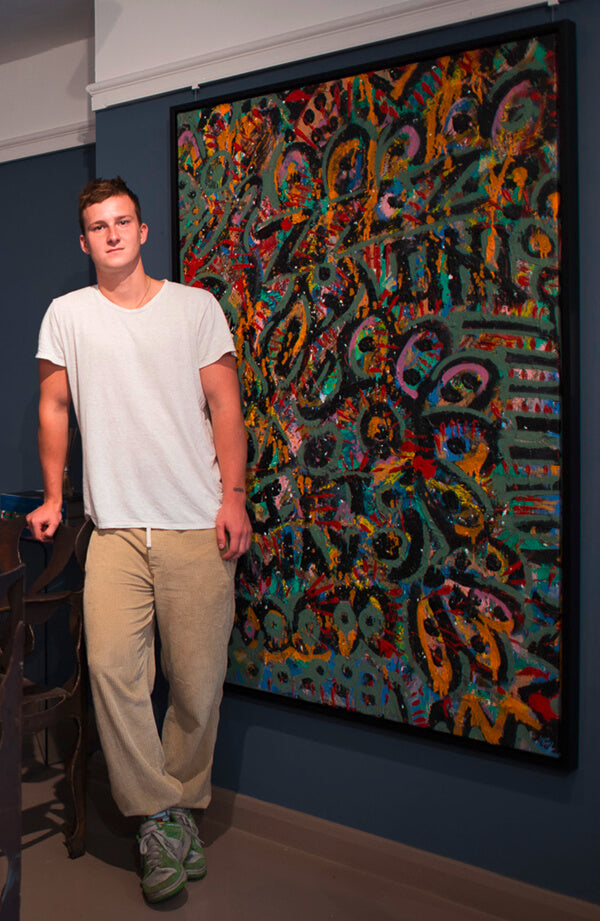

MEET THE MAKER
An interview with Jesse Grylls
Speaking with JESSE GRYLLS, you quickly realise that he takes his work seriously, but himself lightly. Aged just twenty-one, his emergence in the art world has been swift.
-
Jesse’s rise has come more out of creative experimentation than any kind of grand design. He has a genuine ‘obsession with texture and colour, and how things look’. His earliest creations stem from graffiti, street art, and murals rather than fine art. ‘Graffiti was a great place to start,’ he says, ‘doing it for the right reason. No motive. No reputation. Just for the passion of it.’
In 2021, in an unsold unit in Battersea Power Station, Jesse put on his first show. ‘I’d never been to an exhibition before’ he remarks. The pandemic had given space for Jesse to create a distinct collection that made up that first show – ‘I got completely obsessed’ he shares, ‘I was just painting for me – people can interpret it how they want’. The show was a success and a catalyst, ‘I hit the ground, and started running with it’. -
“It’s only interesting expression if it’s honest expression”
Openness and a lack of self-consciousness remain integral (and refreshing) traits of Jesse’s work. ‘It’s only interesting expression if it’s honest expression’ he explains. The amount of himself that Jesse puts into each piece is clear to see. ‘If I do a great painting, I’m knackered’ he says. ‘It’s me putting everything I feel on the page. As humans, our job is to convey feeling—when we experience art, feeling is more important than thinking.’
Jesse’s latest exhibition, Splash, was held at the Tanya Baxter Contemporary on the King’s Road, London. ‘It’s the first show where I’ve worked without characters; moving away from lettering.’ The work mixes mediums, bringing together acrylic, spray paint, oil paints, and oil sticks. ‘I tried to keep it poetic and lyrical,’ he shares, despite the absence of actual letters within the art. ‘I’ve become obsessed with asemic writing,’ he explains. Asemic writing is the use of shapes and motion that have the visual characteristics of text, but without meaning – leaving the interpretation up to the viewer. ‘The emotion is more important than the getting of it.’
This theme, of allowing the viewer to define his art, runs through Jesse’s work. When asked whether it’s tough to see his work go once sold, he’s candid – ‘each piece captures how I feel in the moment, a week later I’ll be feeling different. I don’t feel attached to that expression like I did in the moment’. -
“Creativity is a muscle, the more you use it, the stronger it gets. You’re not born with it”
‘Creativity is a muscle,’ shares Jesse, ‘the more you use it, the stronger it gets. You’re not born with it’. You’ll be as likely to find Jesse with a guitar, or writing, as you will with a brush. He stresses the importance of music; before painting he’ll play for hours as part of the process. As an artist, you get the sense that he’s as likely to create a soundscape or release a book of poetry next as he is to work on canvas.
This relentless creativity comes through in his career to-date, switching mediums and palettes. ‘The mediums mark chapters in my life,’ he explains – when asked if we can expect more shifts, it’s an emphatic yes. He’s currently exploring texture, experimenting with sand and oils in his studio, a chaotic space in South London, covered in paint, with canvasses stacked high. -

So immersive is Jesse’s creative process, and so large its scale, that he had to give up oil paints for a season – ‘it was making me ill,’ he says of the fumes, ‘my immune system was shot’.
While emotion, feeling, and personal experience shape Jesse’s process of making, he acknowledges that there’s more to the purpose of his art. ‘If it was just for me, I’d never show it to anyone – it would just be stacked up in my studio.’ Instead, Jesse sees his art in a wider frame – ‘a lot of how I see life goes into my work. I hope it’s putting something positive back into the world.’
When it comes to navigating the industry and getting his work out there, Jesse is a realist. ‘Being good is a pre-requisite for any artist, that’s the bare minimum,’ he continues, beyond that it’s about the breaks and how people interpret and perceive the work. Asked about the impact of being his father’s son – Jesse is the eldest son of Bear Grylls – he’s open, ‘It definitely gave me a foot in the door...’ he pauses, ‘but if he was cooler, it probably would make more of a difference’. Laughing, he quickly follows-up – ‘Don’t get me wrong, my dad is a legend, he’s just not necessarily a figure in the art world.’
Since his first show in Battersea Power Station just three years ago, Jesse has released a staggering body of work – demonstrating undeniable talent but more than that, an honesty and vulnerability that makes his art distinctly original and instantly compelling.


